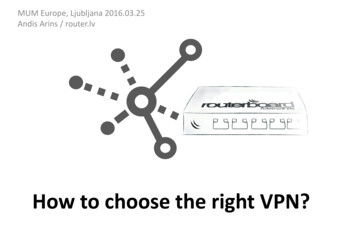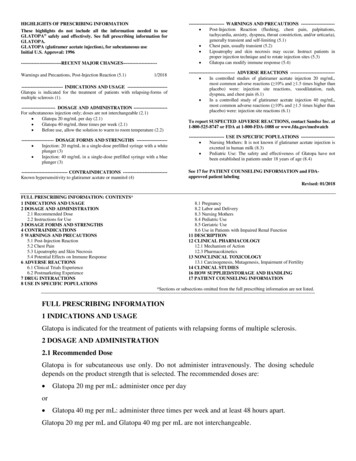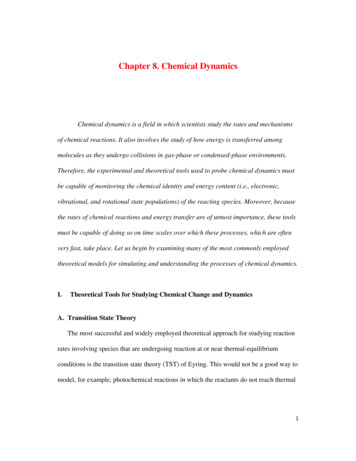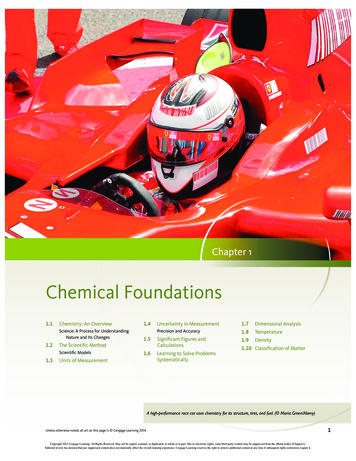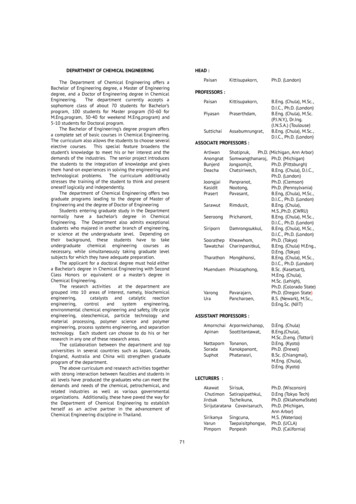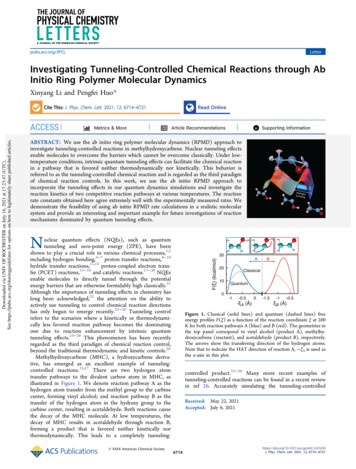
Transcription
pubs.acs.org/JPCLLetterInvestigating Tunneling-Controlled Chemical Reactions through AbInitio Ring Polymer Molecular DynamicsXinyang Li and Pengfei Huo*Cite This: J. Phys. Chem. Lett. 2021, 12, 6714 6721Downloaded via UNIV OF ROCHESTER on July 16, 2021 at 17:23:47 (UTC).See https://pubs.acs.org/sharingguidelines for options on how to legitimately share published articles.ACCESSMetrics & MoreRead OnlineArticle Recommendationssı Supporting Information*ABSTRACT: We use the ab initio ring polymer molecular dynamics (RPMD) approach toinvestigate tunneling-controlled reactions in methylhydroxycarbene. Nuclear tunneling effectsenable molecules to overcome the barriers which cannot be overcome classically. Under lowtemperature conditions, intrinsic quantum tunneling effects can facilitate the chemical reactionin a pathway that is favored neither thermodynamically nor kinetically. This behavior isreferred to as the tunneling-controlled chemical reaction and is regarded as the third paradigmof chemical reaction controls. In this work, we use the ab initio RPMD approach toincorporate the tunneling effects in our quantum dynamics simulations and investigate thereaction kinetics of two competitive reaction pathways at various temperatures. The reactionrate constants obtained here agree extremely well with the experimentally measured rates. Wedemonstrate the feasibility of using ab initio RPMD rate calculations in a realistic molecularsystem and provide an interesting and important example for future investigations of reactionmechanisms dominated by quantum tunneling effects.Nuclear quantum effects (NQEs), such as quantumtunneling and zero-point energy (ZPE), have beenshown to play a crucial role in various chemical processes,1,2including hydrogen bonding,3 7 proton transfer reactions,8 10hydride transfer reactions,11,12 proton-coupled electron transfer (PCET) reactions,13 16 and catalytic reactions.17 20 NQEsenable molecules to directly tunnel through the potentialenergy barriers that are otherwise formidably high classically.21Although the importance of tunneling effects in chemistry haslong been acknowledged,22 the attention on the ability toactively use tunneling to control chemical reaction directionshas only begun to emerge recently.23 26 Tunneling controlrefers to the scenarios where a kinetically or thermodynamically less favored reaction pathway becomes the dominatingone due to reaction enhancement by intrinsic quantumtunneling effects.23 26 This phenomenon has been recentlyregarded as the third paradigm of chemical reaction control,beyond the traditional thermodynamic and kinetic controls.26Methylhydroxycarbene (MHC), a hydroxycarbene derivative, has emerged as an excellent example of tunnelingcontrolled reactions.23,27 There are two hydrogen atomtransfer pathways to the divalent carbon atom in MHC, asillustrated in Figure 1. We denote reaction pathway A as thehydrogen atom transfer from the methyl group to the carbinecenter, forming vinyl alcohol; and reaction pathway B as thetransfer of the hydrogen atom in the hydroxy group to thecarbine center, resulting in acetaldehyde. Both reactions causethe decay of the MHC molecule. At low temperatures, thedecay of MHC results in acetaldehyde through reaction B,forming a product that is favored neither kinetically northermodynamically. This leads to a completely tunneling XXXX American Chemical SocietyFigure 1. Classical (solid lines) and quantum (dashed lines) freeenergy profiles F(ξ) as a function of the reaction coordinate ξ at 200K for both reaction pathways A (blue) and B (red). The geometries inthe top panel correspond to vinyl alcohol (product A), methylhydroxycarbene (reactant), and acetaldehyde (product B), respectively.The arrows show the transferring direction of the hydrogen atoms.Note that to indicate the HAT direction of reaction A, ξA is used asthe x-axis in this plot.controlled product.23 26 Many more recent examples oftunneling-controlled reactions can be found in a recent reviewin ref 26. Accurately simulating the tunneling-controlledReceived: May 22, 2021Accepted: July 6, 0J. Phys. Chem. Lett. 2021, 12, 6714 6721
The Journal of Physical Chemistry Letterspubs.acs.org/JPCLq indicate the initial time and time t. In addition, h is the sideoperator, which is a Heaviside function of the reactioncoordinate ξ that differentiates the reactant versus the product,and - is the flux operator which is the time derivative of theside operator -(q̅ 0, p0̅ ) h[̇ ξ(q̅ 0)]. Further, ⟨···⟩c denotes theensemble average over trajectories that are initially constrainedon the dividing surface ξ‡. The dividing surface is chosen as thecollective coordinate that maximizes the potential of meanforce.10,40 Note that the RPMD rate is proven to be dividingsurface independent.30,31The transmission coefficients as well as the free energyprofiles are evaluated with the ring polymer trajectoriesgoverned by the RPMD Hamiltonian Ĥ n in eq 1, whereasthe potential V(qj) is evaluated through ab initio on-the-flysimulations. The largest κ(t) simulation of this work requires1the on-the-fly propagation of a 3 5 n 7*64 448-atomfictitious molecular ring-polymer for up to 103 trajectories,with at least 450 electronic structure calculations along everysingle ring polymer trajectory. Additional details of thenumerical simulations are provided in the section Theoreticaland Computational Approaches. Using the ab initio RPMDapproach combined with the enhanced sampling technique(the blue moon ensemble approach,42 44 see details in theSupporting Information), we can directly compute the classical(when using n 1) and quantum mechanical free energyprofiles (potential of mean force).The RPMD rate is closely connected with the instanton rateconstant, which has been extensively discussed by Althorpeand co-workers.45,46 The instanton rate constant can bederived on the basis of a steepest descent approximation of thequantum flux-side correlation function,46 48 resulting ink inst A inst e : / ℏ , w h e r e A i n s t i s a p r e f a c t o r a n dÄMβℏ ÅÑÉ: dτÅÅÅÅ 2 q ̇ 2 V (q)ÑÑÑÑ is the Euclidean action (in the0ÇÖimaginary time τ and q ̇ dq/dτ ) measured along theinstanton trajectory q(τ). The ring-polymer potentialÄÉÑN Å1 j 1 ÅÅÅÅV (q j) 2 Mωn2(q j q j 1)2 ÑÑÑÑ in Hn (eq 1) is simply aÅÇÑÖdiscretized version of S/ℏ. For a symmetric system, the ringpolymer beads at the dividing surface describe a finitedifference approximation to the “instanton” trajectory, which isa periodic orbit in imaginary time on the inverted potentialsurface.45,46 The instanton theory also qualitatively explains thetunneling-controlled reactivities: If two mechanisms arecompeting, the one that minimizes the value of : willdominate the product, not necessarily the one with a lowerpotential barrier as predicted by classical TST.46 Only underthe classical limit (high temperature or low barrier frequency)does kinst reduce to the classical TST rate and the potentialbarrier dictate the rate.46We note that molecular reactions of the MHC moleculehave been investigated with the instanton theory in ref 27. Theinstanton theory employed in that work is based on a steepestdescent approximation (harmonic approximations for thethermal fluctuations) for all nuclear DOFs. The steepestdescent approximation used in the instanton theory is not validfor systems with large anharmonicity.47 This potential issue ofsteepest descent can be partially addressed by using the socalled free energy instanton theory,45,49,50 where the steepestdescent approximation is only applied to the reactioncoordinate. However, this approach requires computing thechemical reaction requires an explicit description of the NQEs,which is beyond classical rate constant theory or classicalmolecular dynamics simulation.In this work, we use ring polymer molecular dynamics(RPMD)10,28 31 to compute the reaction rate constants fortwo competing reaction paths in the MHC molecule. RPMD isan approximate quantum dynamics approach based onFeynman’s imaginary-time path-integral formalism,32 whichprovides exact quantum statistics and approximate yet accuratequantum dynamics.28,33,34 In this formalism, each atom isrepresented by a ring polymer of n beads (imaginary-timeslices), with a harmonic spring connecting the adjacentbeads.35Quantum reaction rate constants can be accurately evaluatedusing the RPMD flux-side correlation function formalism,which has been extensively discussed in the previousliterature.11,13,29 31,36 Here, we demonstrate perhaps the firstab initio RPMD rate constant calculation. We combine RPMDwith ab initio on-the-fly simulations at the level of Kohn Sham DFT (with the BLYP functional37 39 and in its singletstate) using a plane-wave basis to investigate the competinghydrogen atom transfer (HAT) reactions in MHC. Thecomputational details are provided in the section Theoreticaland Computational Approaches.For a molecular system with 5 total nuclear degrees of1freedom (DOF) (or 3 5 total number of atoms), thecorresponding ring polymer Hamiltonian is expressed asÄÅ 2ÉÑÑÑn ÅÅÅ p j1Å22ÑÅHn(p, q) ÅÅ V (q j) Mωn (q j q j 1) ÑÑÑÑÅÅ 2MÑÑ2j 1 ÅÑÖÑÇÅ(1)where n is the total number of copies (beads) of the originalq j {[q1]j , [q2]j , ., [q5 ]j } a n dsystem,andpj {[p1 ]j , [p2 ]j , ., [p5 ]j } are the position and momentumvectors of the j t h bead, respectively, with massM {M1 , M 2 , ., M5 }. Further, V(q j ) is the adiabaticpotential energy surface for the nuclei, and the interbeadring polymer frequency is ωn n/βℏ.The approximate quantum mechanical rate constant iscalculated as the plateau value of the RPMD flux-sidecorrelation function.10,28,31 To facilitate numerical simulations,we apply the Bennett Chandler scheme40 that expresses therate constant as follows10,13,36k lim κ(t ) ·k QTSTt tp(2)where tp refers to the plateau time of the flux-side correlationfunction, kQTST is the RPMD-Transition State Theory (TST)rate constant which has been shown to be equivalent to thequantum TST (QTST) rate constant,41 and κ(t) is thetransmission coefficient that captures the dynamical recrossingeffect. The details of kTST are provided in the sectionTheoretical and Computational Approaches at the end ofthis Letter, and κ(t) is expressed as followsκ (t ) ⟨- ·h[ξ(q̅ t) ξ ‡]⟩c⟨- ·h[ξ(̇ q̅ 0)]⟩c1 pn j jLetter(3)1 n jwhere p̅ and q̅ q j are the centroids of themomenta and positions, respectively. The 0 and t subscripts . Phys. Chem. Lett. 2021, 12, 6714 6721
The Journal of Physical Chemistry Letterspubs.acs.org/JPCLLetterquantum free energy profile, with the computational costequivalent to the RPMD-TST rate constant calculation.50 Asextensively investigated in ref 50., the RPMD-TST rate isgenerally more accurate than the free energy instantoncalculation over all temperatures, especially for multidimensional molecular systems. In this paper, explicit dynamicalrecrossing is also considered by computing the transmissioncoefficient. For these reasons, RPMD is the most widelyapplicable of these path-integral rate methods.46Figure 1 presents the classical potential of mean force (solidcurves) and the quantum potential of mean force (dashedcurve) F(ξ) (defined in eq 5) at T 200 K, along the reactioncoordinate ξ (defined in eq 4) for both reaction A (blue) andB (red). It is clear that the classical free energy barrier ofpathway B is higher than reaction A but also thinner thanpathway A. Compared with the classical free energy barrier, thequantum free energy barriers are significantly lower for bothreaction pathways. Further, reaction B is now having an evenlower free energy barrier than reaction A. This is because theNQEs start to dominate the reaction mechanism below thecrossover temperatures45 TC ℏω‡2 π kBwhere ω‡ is the imaginarybarrier frequency at the transition state (TS), and tunneling ismore sensitive to the barrier width, rather than the potentialbarrier height. The crossover temperatures were reported to be321 and 462 K for pathways A and B, respectively.27 Sincetunneling effects are essential to the reaction mechanism belowthe crossover temperature, this highlights the importance ofusing a method which includes tunneling effects in thesimulations of this system.Figure 2A provides the typical configurations of themolecular ring polymer along the reaction coordinate ofreaction B. The labels for each configuration indicate aparticular value of ξB in panel B. At the transition stateensemble, the ring polymer spans over the barrier into thereactant and product sides. The reaction pathway B allowsmost of the beads to reach lower potential positions, due to athinner potential barrier. Since the ring polymer radius isparticularly large when T is small (due to the lower ωn in Hn ofeq 1), this effect plays an essential role at low temperatures inlowering the effective potential that the ring polymer feels,resulting in a lower free energy barrier.Figure 2B presents free energy profiles F(ξ) at 200 K ofreaction pathway B, computed with the classical ab initio MD(AIMD) with n 1 (red) and the quantum RPMD with n 32(blue). Apparently, without considering NQEs, classical AIMDoverestimates the free energy barrier height by more than 10kcal/mol.After reaching the TS configuration (II in Figure 2A), themolecular ring polymer goes into a “sliding downhill” process,as it appears that it directly cuts through the barrier. This isbecause at such a low temperature, the ring polymer isoverstretched (III in Figure 2A), and the top of the free energybarrier, based on the centroid coordinate, is no longer able torepresent an optimized dividing surface that minimizesrecrossing.19,45 This causes the maximum of the free energyto deviate from the maximum of the potential energy surfacefor an asymmetric double-well system.45 We emphasize thatthis is a well-known feature of RPMD, which does notsignificantly influence the accuracy of the rate constant so longas κ(t) (which accounts for the recrossing) is also explicitlyincluded in the rate constant.45Figure 2. Simulation results for reaction pathway B at 200 K. (A) Thetypical ring polymer configurations of the reactant (I), TS (II),product (IV), as well as a configuration (III) between the TS andproduct. (B) The classical (red) and quantum (blue) free energyprofiles F(ξ) as a function of the reaction coordinate B ξB. (C) Theclassical (red) and quantum (blue) transmission coefficients κ(t).Figure 2C presents the classical and quantum timedependent transmission coefficients κ(t) at 200 K for thereaction pathway B. At short times, there is a “tug of war” onthe centroid between the vibrating ring polymer beads in thereactant and product wells, which results in a pronouncedoscillation in the transmission coefficient.51 The plateau valueκ(tp) is lower in the quantum simulation compared with theclassical one.11,13To investigate the temperature dependence of the rateconstant, we also perform the simulations at T 400, 300, and120 K for reaction pathway B. Similarly, we computed thesequantities for reaction pathway A. These additional results areprovided in the Supporting Information (Figure S1). Figure 3Apresents the ring polymer transition state configurations at fourtemperatures. The radius of the ring polymer for all atomsincreases as the temperature decreases, because the springconstant of the ring polymer becomes weaker (ωn T). As aresult, the ring polymer of the transferring hydrogen atombecomes more stretched on the top of the potential barrier,indicating a stronger tunneling effect.Figure 3B presents the temperature dependence of the freeenergy profile along the reaction coordinate ξB. As weexpected, the free energy barrier becomes lower at a lowertemperature. As we have discussed previously, when the1temperature is below 2 Tc (half of the crossover temperature),there is a clear “edge cutting” behavior along the reactioncoordinate, which originates from evaluating the free energyprofile with a centroid coordinate.19,45Figure 3C presents the transmission coefficients κ(t)computed under four different temperatures. Not surprisingly,the plateau value κ(tp) decreases at as temperature 30J. Phys. Chem. Lett. 2021, 12, 6714 6721
The Journal of Physical Chemistry Letterspubs.acs.org/JPCLLetterkTST computed from the free energy barrier heights and theplateau value of the transmission coefficients κ(tp) into eq 2.There exists a crossover of the two rate constants in thetemperature range between 200 and 300 K, indicating a switchin the preferred reaction mechanism. Under the hightemperature limit, the free energy barrier of reaction pathwayA is much lower than the barrier of pathway B (by around 5kcal/mol at T 400 K). Consequently, the reaction rate ofpathway A is higher in this case, making vinyl alcohol thepreferred product.Under lower-temperature conditions, the quantum freeenergy barriers for both pathways decrease. However, asshown in Figure 1, the barrier of the pathway B drops muchfaster than that of pathway A. As a result, tunneling effectsreduce the effective free energy barrier of pathway B moresignificantly. Given the fact that κ(tp) of both pathways are atthe same magnitude at the same temperature (see Figure 3Cand Figure S1B in the Supporting Information), the preferredpathway will be reverted to pathway B at low temperatures.Figure 4 also clearly demonstrates that for T 200 K,nuclear quantum effects start to dominate the reaction rate.Recall that the classical TST theory (Eyring equation) giveslnkT Δ H‡ 1·kB T ‡Δ S‡kB ln‡kB,hwhere h 2πℏ is the Planckconstant, and ΔH and ΔS are the activation enthalpy andFigure 3. Temperature-dependence of reaction pathway B. (A) Therepresentative ring polymer TS configurations at four differenttemperatures. (B) The quantum free energy profiles F(ξ) as afunction of the reaction coordinate B ξB at four temperaturescorresponding to panel A. The free energy barrier ΔF(ξ‡) decreases asthe temperature decreases. (C) The time-dependent transmissioncoefficient κ(t) plots at four different temperatures. The plateau valueκ(tp) decreases as the temperature decreases.entropy (per molecule), respectively. Hence, effective slope of the Eyring plot andΔSkBΔ H‡kB‡ lngives thekBhis theintercept on the y axis. Thus, if the reaction is dominated bythe classical thermal activation process, log k will be a linearfunction of 1/T, with the slope of Δ H‡.kBApparently, this is notthe case for the rate constant presented in this figure, as thelog k starts to plateau with a larger 1/T, which is a commonindicator of the tunneling dominate regime.25,52,53Our theoretical results of the rate constant at a very lowtemperature T 120 K agree with the experimentalobservations that acetaldehyde is the preferred product,which is measured under T 11 K within three differenthosting matrices (Ar, Kr, and Xe), with corresponding rateconstants (black dashed lines) presented in Figure 4. Althoughwe are comparing our 120 K results with the experimental data1at 11 K, T 120 K is already far below 2 Tc , half of thecrossover temperatures of both pathways. This means that thethermally induced contribution to the reaction rate is minimaland further decreasing the temperature will not change thereaction rate, hence log k should plateau as a function of 1/Tas we have discussed previously. This is why our numericalresults have already shown the trend of approaching theplateau value in Figure 4. Interestingly, the ratio of the two rateconstants in the plateau region of deep tunneling from ourcalculation is log kB/kA 3.7, in a good agreement with theexperimentally23 measured value 3.3 under T 11 K.Simulating lower temperature results (T 120 K) requireseven more beads (n 64) in the ring polymer and,consequently, more computational resources. In the future,this can be addressed by incorporating the ring polymercontraction scheme,54,55 where the full ring polymer beadspotential is evaluated with some lower level electronicstructure calculations (such as the Density Functional basedTight Binding) as a “reference” system, while a contracted ringpolymer is evaluated with the higher level theory (such as KS-because of lowered barriers and the complex motion of theoverstretched ring polymer in the intermediate time, whichleads to more recrossing events. The relatively low value ofκ(tp) at 200 K and below also clearly indicates that the top ofthe free energy barrier based on the centroid coordinate is nolonger an optimized dividing surface that minimize recrossing.45,50Figure 4 presents the plots of the rate constant for thereaction pathway A (blue) and B (red), obtained by pluggingFigure 4. Temperature dependence of the rate constants k forpathway A (blue) and pathway B (red). Note that the base-10logarithm is used for plotting log k. Three horizontal black dottedlines present experimentally measured rates at 11 K in three differenthosting matrices.23 The top panels show the typical ring polymerconfigurations of pathways A and B, tt.1c01630J. Phys. Chem. Lett. 2021, 12, 6714 6721
ÅÄC51 ÅÅF(ξ i) lnÅÅÅÅβ ÅÅÇ Q (N , V , T )The Journal of Physical Chemistry Letterspubs.acs.org/JPCLDFT), hence saving a huge amount of computational efforts, asdemonstrated in the recent state-of-the-art AIMD-RPMDsimulation of water.54,55 Another potential challenge arisesfrom the fact that the centroid coordinate deviates from theoptimal dividing surface for low temperatures, resulting in anumerically small plateau value of κ(tp) (that might even beclose to 0), which requires a large number of trajectories toconverge. This can be potentially addressed by incorporatingthe knowledge from other noncentroid modes into thecollective coordinate.30,31,45In conclusion, we have reported, to the best of ourknowledge, the first ab initio on-the-fly RPMD rate constantcalculation. We use it to investigate tunneling-controlledreactions in methylhydroxycarbene. We computed the freeenergy profiles and reaction rate constants of two hydrogentransfer pathways in methylhydroxycarbene. Our resultssuggest that below the crossover temperature, intrinsicquantum tunneling effects can facilitate the chemical reactionin a pathway that is neither favored thermodynamically norkinetically, opening up new possibilities to enable chemicaltransformations. Further, our ab initio RPMD rate constantcalculations provide accurate rate constants of the reactionsthat are in excellent agreement with the experimentalmeasurements.23 We demonstrated that RPMD can beconveniently combined with ab initio on-the-fly simulationsto investigate a realistic hydrogen atom transfer system underthe tunneling-controlled reaction regime. This work providesan interesting and important example of using ab initio RPMDto investigate reactions dominated by quantum tunnelingeffects26 to provide detailed mechanistic insights.where Hn(p, q) is the ring polymer Hamiltonian defined in eq1 βHn(p, q)1, C5 is the5 , and Q (N , V , T ) d pd qe(5 / 3)! hring polymer canonical partition function. The PMF iscomputed using path-integral Car Parrinello moleculardynamics (CPMD) simulations. The fictitious electron massm 400 au is used in the CPMD-PIMD simulations. A massiveNosé Hoover chain thermostat60 on every nuclear DOF isused to maintain a NVT ensemble in the simulation box. Thepath-integral molecular dynamics (PIMD)61 propagation isused for the nuclei, using fictitious nuclear masses (Parrinello Rahman mass) that are 4 times their respective physical massesto facilitate the sampling of the ring polymer configurations.We have carefully checked that the CPMD generated PMF isidentical to the Born Oppenheimer MD generated PMF forboth the classical dynamics and the PIMD dynamics, withresults provided in the Supporting Information. Since the freeenergy barriers for both pathways are much higher comparedto thermal fluctuations,23 the blue moon ensemble approach42 44 (an enhanced sampling technique) is used tofacilitate the free energy calculations in the canonical (NVT)ensemble. The details of the blue moon ensemble simulationare provided in the Supporting Information. A set of 40constrained MD simulations are performed along the reactioncoordinate from the reactant to the product in the NVTensemble. The time step is set to be 0.072 fs. Each trajectory isthen equilibrated for at least 0.5 ps, followed by a productionrun of at least 1 ps.A rough estimation of the number of beads needed can beobtained using n ℏωmax/kBT, where ωmax is the maximumfrequency of the molecule. Normal mode analysis at the levelof B3LYP/cc-pVTZ using Gaussian 09 package62 gives ωmax 3826 cm 1 (the O H bond stretching frequency) for theMHC molecule. This leads to n 28 for T 200 K and n 46for T 120 K. The number of beads n used for nucleiquantization in the actual simulations at various temperaturesare listed in Table 1. We have carefully checked the beadconvergence, with details provided in the SupportingInformation.THEORETICAL AND COMPUTATIONALAPPROACHESAll simulations, including the free energy profile andtransmission coefficient calculations, are performed with anin-house modified version of the CPMD56 package version3.15.3. The molecule is simulated with the BLYP functional37 39 in its singlet electronic ground state. The moleculeis placed in an isolated simulation box of 8 Å which is treatedwith Martyna Tuckerman formalism,57 and a plane-wave basiswith a cutoff of 80 Ry. The core electrons were treated withTroullier Martins pseudopotentials.58 The normal moderepresentation of the ring polymer is used to propagate thetrajectories in all simulations.59To characterize the progress of the reaction, we use thefollowing reaction coordinate(q qD) ·(qA qD)R DH·R DA H R DA qA qD (5) ξ(q) ÑÉÑÑd pd qe βHn(p, q)δ(ξ ξ i)ÑÑÑÑÑÑÖLetterTable 1. Number of Beads Used at Different Temperaturesin Our SimulationsT (K)n40016300162006412064The ring polymer molecular dynamics transition state theory(RPMD-TST) rate constant kTST accounts for the ratecomponent purely dictated by quantum statistics (quantumfree energy barrier height). It has been shown that kTSTcoincide with the quantum mechanical TST rate theory,41explaining the success of the RPMD rate theory. The RPMDTST rate kTST is expressed as(4)where H, D, and A denote the transferring hydrogen atom, thedonor atom, and the acceptor atom, respectively. This reactioncoordinate19 measures the length of the projection of vectorRDH onto the axis that connects the hydrogen donor andacceptor atoms. The larger the reaction coordinate is, thecloser the transferring hydrogen is to the acceptor atom. For1the RPMD simulations, the centroid coordinate q̅ n j q j isk TST used in the above expression.The potential of mean force (PMF) F(ξ) at reactioncoordinate ξi is defined as1⟨g ⟩c2πβ ξ‡e β Δ F(ξ )ξ‡ e β Δ F(ξ)dξ(6)where ξ(q̅) denotes the centroid reaction coordinate (definedin eq 4), ξ‡ denotes the value of the dividing surface along J. Phys. Chem. Lett. 2021, 12, 6714 6721
The Journal of Physical Chemistry Letterspubs.acs.org/JPCLreaction coordinate, which is obtained at the highest value ofF(ξ(q̅)) along ξ(q̅), and ΔF(ξ‡) represents the free energybarrier height from the bottom of the reactant well to the topof the free energy barrier at ξ ξ ‡ . Further,5 1 i ξ(q) y i 1 M jjj q ̅ zzzii̅orcid.org/0000-0002-8639-9299; Email: pengfei.huo@rochester.eduAuthorXinyang Li Department of Chemistry, University ofRochester, Rochester, New York 14627, United StatesComplete contact information is available 02, where i is the index of the nucleark{DOF, Mi is the corresponding mass, and 5 is the total numberof DOF. This quantity serves as the square root of the inversereduced mass of the reaction coordinate.To compute κ(t) in eq 3, one needs to define the followingside operator h, which is a Heaviside function of the reactioncoordinate ξ defined asgξ (q̅) l1, ifξ ξ ‡ooh[ξ(q̅ t)] omooo 0, ifξ ξ ‡.nNotesThe authors declare no competing financial interest. ACKNOWLEDGMENTSThis work was supported by the National Science FoundationCAREER Award under Grant No. CHE-1845747. Computingresources were provided by the Center for Integrated ResearchComputing (CIRC) at the University of Rochester, as well asby XSEDE under Grant No. CHE-190016. The authorsappreciate valuable comments to the manuscript from EricKoessler.(7)The flux operator is the time derivative of the side operator,expressed as5-(q̅ 0, p0̅ ) h[̇ ξ(q̅ 0)] δ(ξ ξ‡)i 1dξp̅dqi̅ i (8)ASSOCIATED CONTENTsı Supporting Information*The Supporting Information is available free of charge 1630.Computational details, additional results for reactionpathway A, choice of the density functional, tests of beadconvergence, free energy profiles computed fromdifferent approaches (PDF) REFERENCES(1) Markland, T. E.; Ceriotti, M. Nuclear Quantum Effects Enter theMainstream. Nat. Rev. Chem. 2018, 2, 0109.(2) Hammes-Schiffer, S. Quantum Effects in Complex Systems:Summarizing Remarks. Faraday Discuss. 2020, 221, 582 588.(3) Kawashima, Y.; Tachikawa, M. Nuclear quantum effect onintramolecular hydrogen bond of hydrogen maleate anion: An abinitio path integral molecular dynamics study. Chem. Phys. Lett. 2013,571, 23 27.(4) Fang, W.; Chen, J.; Rossi, M.; Feng, Y.; Li, X.-Z.; Michaelides, A.Inverse Temperature Dependence of Nuclear Quantum Effects inDNA Base Pairs. J. Phys. Chem. Lett. 2016, 7, 2125 2131.(5) Litman, Y.; Richardson, J. O.; Kumagai, T.; Rossi, M. Elucidatingthe Nuclear Quantum Dynamics of Intramolecular Double HydrogenTransfer in Porphycene. J. Am. Chem. Soc. 2019, 141, 2526 2534.(6) Pérez, A.; Tuckerman, M. E.; Hjalmarson, H. P.; von Lilienfeld,O. A. Enol Tautomers of Watson-Crick Base
ABSTRACT: We use the ab initio ring polymer molecular dynamics (RPMD) approach to investigate tunneling-controlled reactions in methylhydroxycarbene. Nuclear tunneling effects enable molecules to overcome the barriers which cannot be overcome classically. Under low-temperature conditions, intrinsic quantum tunneling effects can facilitate the chemical reaction in a pathway that is favored .

